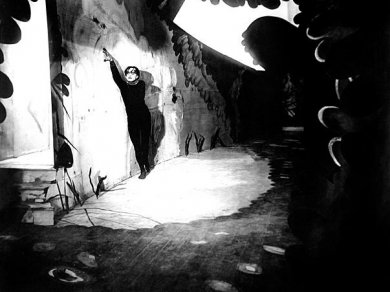
Since the invention of film there have been many different movements and styles that have come to shape how movies are made. One of the earliest of film movements was German Expressionism. Many see the German Expressionist era as the first stylistic film movement in history, and there is good cause to believe this. Not only is this one of the first film movements but it is also one of the most influential in the modern era.
German expressionism began in the early days of film, at the beginning of the twentieth century. During the First World War expressionism found its stride, and by the early twenties it had peaked. Two of the most recognizable expressionist films are Nosferatu (Murnau, 1922), and The Cabinet of Dr. Caligari (Wiene, 1920). By the end of the twenties, expressionism had started to fade out in Germany, and as the Nazi party gained power, many of the filmmakers involved in expressionist movies left for America.
When watching one of these classics the first thing that the eye catches is the extensive set design and use of lighting. There is heavy use of shadow that can often be compared to film noir of the forties and fifties. Like film noir, one can see the shadows as their own character, which plays an important part in the film. The creators of Dr. Caligari realized this and even went so far as to paint shadows onto the set in order to obtain the desired look. The shadowed lighting also emphasizes the obscure sets. These sets are very unique and were rarely seen before the creation of expressionist cinemas. In Nosferatu the shadow of Orlok is shown almost as much as the character himself is shown, which is a technique still seen in horror films today.
Many contemporary film sets of towns and rural areas maintained realism, attempting to recreate how the area may have actually looked. Expressionist sets ignore this and go for complete creativity. This can be seen in The Cabinet of Dr. Caligari, which had an extensive use of unique sets and backdrops. There are several scenes from Caligari where abstract and uneven sets play an important role in the structure of the film. For instance, several scenes set on city streets highlight the unusual buildings and help to intensify the unease that the film conveys.
Nosferatu and Dr. Caligari, like most other expressionist films of the period, were horror films. This led the way for some of the classic Hollywood monsters of the thirties and forties. This wasn’t the only way that expressionist films helped to inspire Hollywood. There have been many other Hollywood productions that take example from German Expressionism. One of the most famous modern directors, Tim Burton, has made several movies that have many striking similarities to classic expressionist cinema. Burton’s film Sleepy Hollow (1999) is one of the most recognizable examples of modern expressionism that takes inspiration from German films of the twenties. In the film the use of abstract sets and lighting is crucial to the tone of the film, and while there is much heavier use of CGI and special effects, the concepts are still all there. Burton is widely known for his unique approach to filmmaking, and when you watch any film from the expressionist era, you can see where he gets his inspiration.
Burton has had a tremendous effect on Hollywood over the past three decades, and many of his films are widely loved. Key to knowing his inspiration shows the artistic process of his films and knowing just what to expect from a Tim Burton movie. With the great success Burton saw with his films, he was granted more creative freedom and was able to help the neoexpressionist movement to grow. From this growth came another great modern expressionist film that goes outside the Hollywood system; the Spanish film El Labertino Del Fauno (2006) directed by Guillermo Del Toro.
The film, translated as Pan’s Labyrinth in English, was a massive success but also found a great balance in combining two very different yet complementary forms of filmmaking. Pan’s Labyrinth is at its core an expressionist fairy tale, but it is expressionism wrapped in realism. This is where Hollywood seems to be going with many of its future expressionist productions. Even films like Big Fish (Burton, 2003) and Life of Pi (Lee, 2012) are a great variation on fairy tale stories with a combination of expressionism and realism. The two styles are opposites but are complementary of each other and allow more depth to stories that both capture our imagination and bring us into a world we can feel familiar with.
In order to examine modern cinema, it is necessary to know where the inspiration for many of these films came from. With the knowledge of the expressionist era, we can identify and relate to neoexpressionist films produced today. There are many directors that are still active members of the neoexpressionist movement. Tim Burton and Guillermo Del Toro are two of many filmmakers that create these stories. While both work heavily in the Hollywood system, they still, from time to time, break away and produce fantastic expressionist works outside of American cinema.


 RSS Feed
RSS Feed
